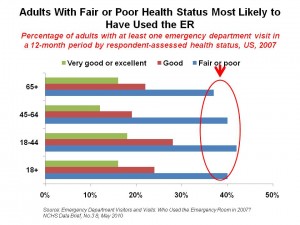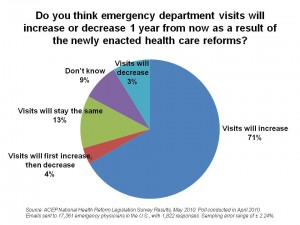 As demand for emergency room services has grown for the past 15 years, there’s been a tacit inference that it’s people without health insurance who populate ERs and cause long waits.
The fact is that people who are most likely to visit emergency departments have insurance, and its name is Medicaid. And people with and without usual sources of medical care were equally likely to visit an ER in a 12-month period.
Furthermore, as the bar chart illustrates, its less healthy people who are also most likely to use the ER. Note that within each health status group, the percentage of adults with at least one ER visit varied little across age groups.
The National Center for Health Statistics (NCHS) analyzed ER visit data from 2007 and learned that among the under-65 year old population, the uninsured were no more likely than insured people to have had at least one visit to an ER in a 12-month period. Nor were visits by uninsured people less urgent than people with either private insurance or Medicaid.
As demand for emergency room services has grown for the past 15 years, there’s been a tacit inference that it’s people without health insurance who populate ERs and cause long waits.
The fact is that people who are most likely to visit emergency departments have insurance, and its name is Medicaid. And people with and without usual sources of medical care were equally likely to visit an ER in a 12-month period.
Furthermore, as the bar chart illustrates, its less healthy people who are also most likely to use the ER. Note that within each health status group, the percentage of adults with at least one ER visit varied little across age groups.
The National Center for Health Statistics (NCHS) analyzed ER visit data from 2007 and learned that among the under-65 year old population, the uninsured were no more likely than insured people to have had at least one visit to an ER in a 12-month period. Nor were visits by uninsured people less urgent than people with either private insurance or Medicaid.
 Health Populi’s Hot Points: Given these myth-busting findings, NCHS concludes that, “Future work should focus on untangling the complex interactions among the sociodemographic, health status, and health care access factors that appear to be associated with visits to the ED.”
The American College of Emergency Physicians (ACEP) polled its membership in April 2010 to learn about the current state of ERs among its key constituents – those on the front-lines of emergency department care. Although NCHS found that 1 in 5 Americans visit the ER annually, based on 2007 data, ACEP believes that ER visits will increase as health reforms are implemented in the U.S. 71% of ACEP membership believes that visits to the ER will increase as a direct result of health reform – only 3% expect visits to decrease, as shown in the pie chart based on survey results.
That’s because the law does not deal with uncompensated care in hospitals or ERs, which has been a growing challenge for health providers in the recession. Consider the recent closing of St. Vincent’s in New York City a hospital which was a crucial site for care in the advent of 9/11. St. Vincent’s is but one emergency department that’s been forced to close in the past several years due to fiscal instability and providing care to people who couldn’t/didn’t pay for services received at the unit.
Emergency doctors, most of whom are dealing with evermore crowded ERs, are skeptical about health reform’s ability to cure their problem. If what they forecast comes to pass, more people will appear on a fewer number of ER doorsteps and not be able to access services when it matters most with or without health coverage. Again, the conundrum of “coverage” for health services versus “access” to those services raises its head.]]>
Health Populi’s Hot Points: Given these myth-busting findings, NCHS concludes that, “Future work should focus on untangling the complex interactions among the sociodemographic, health status, and health care access factors that appear to be associated with visits to the ED.”
The American College of Emergency Physicians (ACEP) polled its membership in April 2010 to learn about the current state of ERs among its key constituents – those on the front-lines of emergency department care. Although NCHS found that 1 in 5 Americans visit the ER annually, based on 2007 data, ACEP believes that ER visits will increase as health reforms are implemented in the U.S. 71% of ACEP membership believes that visits to the ER will increase as a direct result of health reform – only 3% expect visits to decrease, as shown in the pie chart based on survey results.
That’s because the law does not deal with uncompensated care in hospitals or ERs, which has been a growing challenge for health providers in the recession. Consider the recent closing of St. Vincent’s in New York City a hospital which was a crucial site for care in the advent of 9/11. St. Vincent’s is but one emergency department that’s been forced to close in the past several years due to fiscal instability and providing care to people who couldn’t/didn’t pay for services received at the unit.
Emergency doctors, most of whom are dealing with evermore crowded ERs, are skeptical about health reform’s ability to cure their problem. If what they forecast comes to pass, more people will appear on a fewer number of ER doorsteps and not be able to access services when it matters most with or without health coverage. Again, the conundrum of “coverage” for health services versus “access” to those services raises its head.]]>
ER update: people with health coverage more likely to visit, and health reform could worsen overcrowding
By Jane Sarasohn-Kahn on 20 May 2010 in Health Consumers, Health disparities, Health Economics, Health reform, Public health




 Interviewed live on BNN Bloomberg (Canada) on the market for GLP-1 drugs for weight loss and their impact on both the health care system and consumer goods and services -- notably, food, nutrition, retail health, gyms, and other sectors.
Interviewed live on BNN Bloomberg (Canada) on the market for GLP-1 drugs for weight loss and their impact on both the health care system and consumer goods and services -- notably, food, nutrition, retail health, gyms, and other sectors. Thank you, Feedspot, for
Thank you, Feedspot, for  As you may know, I have been splitting work- and living-time between the U.S. and the E.U., most recently living in and working from Brussels. In the month of September 2024, I'll be splitting time between London and other parts of the U.K., and Italy where I'll be working with clients on consumer health, self-care and home care focused on food-as-medicine, digital health, business and scenario planning for the future...
As you may know, I have been splitting work- and living-time between the U.S. and the E.U., most recently living in and working from Brussels. In the month of September 2024, I'll be splitting time between London and other parts of the U.K., and Italy where I'll be working with clients on consumer health, self-care and home care focused on food-as-medicine, digital health, business and scenario planning for the future...